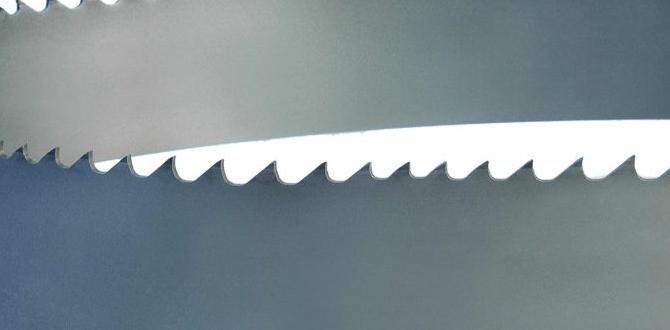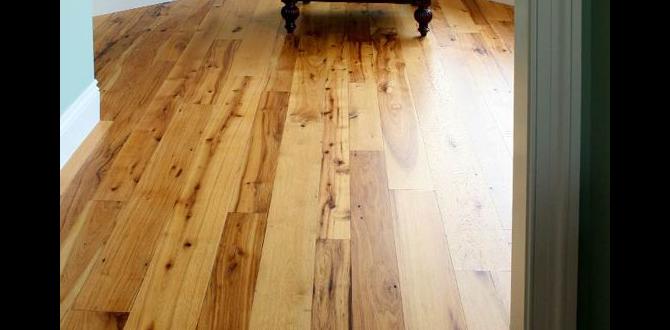Quick Summary:
Keep nails from bending by using the right nail size and type for the material, ensuring your hammer has good balance and is the correct weight, striking the nail head squarely, and maintaining a steady, controlled swing. Proper technique is key!
Hey there, DIYers! Jack Shaffer here from Nailerguy. Ever line up a perfect shot on a nail, swing your hammer with confidence, only to watch that nail bend like a pretzel on impact? It’s one of those little frustrations that can slow down any woodworking project. You’re not alone; it happens to the best of us, especially when you’re just starting out. But don’t worry, those bent nails are completely preventable with a few smart techniques and the right approach. In this guide, we’ll walk through exactly how to keep your nails straight and drive them home smoothly, every time. Stick around, and we’ll get your projects looking sharp!
Table of Contents
Why Do Nails Bend in the First Place? Common Culprits
It can be baffling when a nail just refuses to cooperate. We put our trust in a simple tool, and sometimes, it lets us down. Understanding why nails bend is the first step to preventing it. It’s usually a combination of factors:
- The Wrong Nail for the Job: Using a nail that’s too thin for the material, or a nail meant for softwood in hardwood, is a recipe for disaster.
- Poor Hammer Technique: Hitting the nail head off-center, swinging too wildly, or using a hammer that’s too heavy or too light can cause it to buckle.
- Material Resistance: Driving a nail into dense hardwood, knotty wood, or even hitting a hidden knot can present significant resistance, leading to bending.
- Dull or Damaged Nail Heads: Sometimes, the nail itself isn’t perfect. A slightly bent head or a damaged tip can send it off course.
Identifying these issues helps us focus on the solutions. Let’s dive into how you can master the art of straight nailing.
Choosing the Right Nail: The Foundation of Straight Driving
Think of building a house – you wouldn’t start with a shaky foundation, right? The same applies to nailing. The type and size of the nail you choose are crucial for success. Get this part right, and you’ve already won half the battle.
Nail Types Demystified
Nails come in all shapes and sizes, each designed for a specific purpose. For general DIY and woodworking, you’ll encounter several common types:
- Common Nails: These are stout, with thick shanks and large heads. Great for framing and heavier structural work where holding power is key. They are less likely to bend due to their thickness.
- T-Head and Duplex Nails: Similar to common nails but with a T-shaped head. Duplex nails have a double head, making them easy to remove – ideal for temporary bracing or forms.
- Finishing Nails: These have a small, almost invisible head that can be easily countersunk below the wood surface, leaving a clean look for trim work. They are finer and more prone to bending if not driven carefully or into hard materials.
- Brads and Panel Pins: Even smaller and thinner than finishing nails, these are used for very delicate work, craft projects, or tacking thin pieces of wood. They bend very easily.
- Screws (Not Nails, but worth mentioning!): While not nails, screws offer superior holding power and are less prone to bending. For critical joints or situations where wood might split, screws are often a better choice.
For preventing bent nails, especially when you’re learning, sticking to slightly heavier-gauge nails (like common nails or construction screws) can be more forgiving. When using finer nails, you’ll need to refine your technique even further.
Matching Nail Size to Your Material
This is where the rubber meets the road. The thickness of the wood you’re nailing into dictates the gauge and length of your nail. If your nail is too thick for the wood, it’s going to push the wood fibers aside forcefully, increasing resistance and the chance of bending. If it’s too thin, it might not have the structural integrity to withstand the force.
Generally, the nail shank should be about two-thirds the thickness of the thinner board you are joining. For example, if you’re nailing into a 1-inch thick board (which is actually about 3/4 inch thick), a nail with a diameter in the range of 12-14 gauge is often appropriate. Always consult project plans or material recommendations if you’re unsure.
Here’s a simple guide to common nail sizes:
| Nail Type | Common Lengths | Typical Use | Ease of Bending |
|---|---|---|---|
| Common Nail | 1.5″ to 7″ | Framing, general construction | Low |
| Finishing Nail | 1″ to 4″ | Trim work, moldings | Medium |
| Brad/Panel Pin | 0.5″ to 1.5″ | Crafts, delicate trim | High |
| Galvanized Common | 1.5″ to 7″ | Outdoor projects, decks | Low |
A nail that’s too long can also be problematic. If it’s excessively long, it has more opportunity to hit something it shouldn’t or bind up as it drives, increasing the chance of bending.
The Hammer: Your Partner in Driving Nails
Your hammer is more than just a weight; it’s an extension of your arm. The right hammer used correctly makes all the difference in keeping nails straight.
Choosing the Right Hammer Weight
Hammers come in various weights, typically ranging from 16 ounces to 32 ounces for woodworking and construction. For most DIY tasks involving common nails, a 16-ounce or 20-ounce claw hammer is a good starting point. Heavier hammers deliver more force, which can be good for driving larger nails into tough materials, but they also require more control and can be more tiring. Lighter hammers are easier to control but might require more swings.
The key is balance. A well-balanced hammer feels comfortable in your hand and swings with a natural arc. If the hammer feels too heavy or too light, it can disrupt your control and lead to off-center hits.
Hammer Grip and Stance
How you hold and position yourself with the hammer is fundamental to good technique.
- Grip: For the initial tap and setting the nail, hold the hammer closer to the head. This gives you control. Once the nail is started, move your grip further down the handle for a full swing. Grip firmly but don’t clench your hand tightly; a relaxed grip allows for a smoother swing.
- Stance: Plant your feet shoulder-width apart. Stand so you can swing the hammer in a natural arc without overreaching or straining. Your body should be balanced and stable. This stability translates directly into a more controlled and accurate strike.
Think of it like a baseball swing – balance and controlled power are everything!
The Art of the Strike: Perfecting Your Technique
This is where the magic happens. Even with the right nail and hammer, poor technique will lead to bent nails. Let’s break down the process step-by-step.
1. Setting the Nail
Before you commit to a full swing, you need to get the nail started properly. This is often where problems begin!
The “Tap and Release” Method:
- Position the Nail: Hold the nail between your thumb and index finger, or simply place it against the wood where you want it to go. For trickier spots or if you’re nervous about hitting your fingers, a nail holder tool can be a lifesaver. Many hardware stores carry inexpensive versions.
- The Gentle Tap: With a light, controlled swing, tap the head of the nail just hard enough to set it into the wood’s surface. You want it to stand upright on its own. This usually takes one or two gentle taps.
- Withdraw Your Fingers: As soon as the nail is standing, take your fingers completely out of the way. Don’t be tempted to hold it too long!
If the nail doesn’t set firmly after the first tap, give it another gentle tap. The goal here isn’t to drive it in, but to make sure it’s stable and perpendicular to the surface.
2. The Controlled Swing: Power Meets Precision
Once the nail is set, it’s time for the driving swing. This is where you use the weight of the hammer head.
- Grip Adjustment: Move your hand down to the end of the hammer handle. This gives you leverage and allows the hammer head to build momentum.
- The Swing Path: Think of an arcing motion. Swing from your shoulder and elbow, not just your wrist. Keep your eye trained on the head of the nail.
- The Strike: Aim to hit the center of the nail head squarely. Your goal is to deliver the force directly down the shank of the nail. A glancing blow will almost certainly cause it to bend.
- Follow-Through: A good swing has a natural follow-through. Don’t stop the hammer just as it hits the nail. Allow your swing to complete its arc. This ensures you’re using the hammer’s momentum effectively.
On average, it takes between 2 to 5 solid, well-aimed swings to drive a medium-sized nail completely. If the nail is bending, resist the urge to just hit it harder and faster. Stop, assess, and try again with better precision.
3. What to Do if a Nail Starts to Bend
Even with the best intentions, sometimes a nail will start to go in crooked or buckle. Don’t panic!
- Stop Immediately: The moment you feel or see the nail bending, stop swinging. Continuing to hammer a bent nail will only make it worse, potentially damaging your work surface or breaking the nail.
- Remove the Bent Nail: Use the claw of your hammer to gently pry out the bent nail. For stubborn nails, you might need a nail puller or a block of wood under the hammer head to give you more leverage and protect the surrounding wood.
- Assess and Re-nail: Look at the hole the bent nail left. Sometimes, the wood is too dense or there’s a knot. You might need to try a slightly smaller gauge nail, or even drill a small pilot hole (especially in hardwoods), to make driving easier. Then, try again with proper technique.
Learning to remove a bent nail cleanly is just as important as driving one straight!
Advanced Tips for Stubborn Materials and Tricky Situations
Woodworking isn’t always about soft pine. Sometimes you’ll face dense hardwoods, angled joints, or delicate veneers. Here’s how to tackle those challenges:
Nailing into Hardwoods
Driving nails into hardwoods like oak, maple, or hickory can be tough. The wood fibers are much denser.
- Use Proper Fasteners: Consider specialized hardwood nails, which are often hardened steel. Alternatively, screws are almost always a better option for hardwoods.
- Pilot Holes are Your Friend: For hardwoods, drilling a pilot hole slightly smaller than the nail’s shank diameter is highly recommended. This creates a channel for the nail and prevents the wood from splitting. For stronger joints, you can purchase specialty drill bits designed for pre-drilling nail holes.
- Hammer Technique: Use a slightly heavier hammer if needed, but always prioritize a square, controlled strike. A solid whack is better than many glancing blows. Ensure your hammer is well-balanced for the weight.
According to the U.S. Forest Products Laboratory, understanding the properties of different wood species is key to successful woodworking. Hardwoods require more force and preparation than softwoods.
Nailing at Angles
Sometimes, you need to toenail (drive a nail at an angle) to secure joints. This is trickier!
- Set the Nail Carefully: Start the nail at the desired angle with a very light tap. It’s easy to throw it off course here.
- Short, Controlled Swings: Use shorter, very controlled swings. The angle makes it harder to strike the head squarely. Focus on hitting the center of the nail head.
- Use the Right Nail Length: A slightly shorter nail might be better to avoid it protruding from an unexpected angle.
Working with Thin Wood or Veneers
Fine finishing or delicate tasks require a gentle touch.
- Use the Right Nails: Opt for brads, panel pins, or finishing nails.
- Use a Lightweight Hammer: A 10-ounce or 12-ounce hammer or even a tack hammer is ideal.
- Nail Holder is Essential: A nail holder is almost mandatory here to protect your fingers and guide the nail.
- Gentle Taps: Use very light taps to set the nail, and then 1-2 controlled swings to drive it flush. You might even use a block of wood to hit the hammer head with, giving a very controlled force.
- Countersink: For finishing nails, use a nail set to gently tap the nail head just below the surface after it’s driven.
Using Nail Guns: A Modern Solution
For repetitive tasks or when speed and consistency are paramount, nail guns are fantastic. They significantly reduce the risk of bending nails.
- Choose the Right Nail Gun: From brad nailers for trim to framing nailers for structural work, there’s a gun for every job.
- Use the Correct Nails: Always use the specific nails designed for your nail gun. They come in collation strips that feed directly into the magazine.
- Set the Depth Drive: Most nail guns have an adjustable depth setting. Too deep, and you might dent the wood. Too shallow, and the nail won’t be flush. Practice on scrap wood to find the right setting.
- Safety First: Always follow the manufacturer’s safety instructions. Keep your fingers away from the firing mechanism and the nose of the gun. Never point it at anyone.
Nail guns are an investment, but for frequent DIYers, they can transform projects and eliminate bent nail frustrations entirely.
Tools and Accessories That Help
Beyond the hammer and nails, a few helpful gadgets can make your nailing experience smoother and more successful.
- Nail Holder: As mentioned, these are invaluable for protecting fingers and ensuring a straight start, especially with smaller nails or when working in tight spots.
- Nail Set: A nail set is a small metal rod with a cupped or pointed tip. You use it to drive finishing nail heads slightly below the wood surface without damaging the surrounding area.
- Pliers: Good quality pliers can help with removing stubborn or bent nails.
- Safety Glasses: Non-negotiable! Flying nail fragments or hammer material CAN cause severe eye injury. Always wear them.
- Work Gloves: While some prefer a bare hand feel, gloves can offer a better grip and protect your hands from splinters or minor impacts.
Investing in a few of these inexpensive accessories can greatly improve your nail-driving success rate.
Frequently Asked Questions (FAQ)
Q1: What’s the easiest way to start a nail straight?
The easiest way is to use a nail holder or a pair of pliers to keep the nail steady while you give it one or two very light taps with the hammer to set it into the wood. This allows you to remove your fingers safely and then proceed with a controlled swing.
Q2: How do I avoid bending nails when nailing into really hard wood?
For very hard woods, the best approach is to drill a pilot hole slightly smaller than the nail’s diameter. This guides the nail and reduces resistance. Using screws instead of nails is also a highly recommended alternative for hardwoods.
Q3: My hammer feels heavy. Can I use a lighter one to avoid bending nails?
Yes, if your hammer feels too heavy and you’re having trouble controlling your swings, switch to a lighter one. The key is a controlled, square strike, not brute force from an unwieldy hammer. For general DIY, a 16-oz or 20-oz hammer is usually a good balance.
Q4: Is it okay to keep hammering a nail that’s already started to bend?
No, it’s best to stop immediately. Continuing to hammer a bent nail will likely make it bend further, possibly break, or damage the wood. It’s far more efficient to pull out the bent nail and start again with a fresh one and proper technique.


